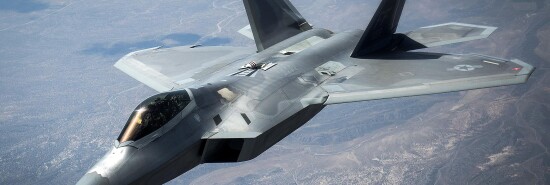
F-22s will not deter Russia in Syria — their shows of force will
Tom Rogan
Video Embed
The United States is deploying F-22 fighter jets from the Air Force’s 94th Fighter Squadron to Syria. Their mission will be to deter Russia from its escalating harassment of U.S. forces in that nation. That harassment has two purposes: to push the U.S. out of Syria (a longtime priority Russian objective) and to earn Beijing’s favor for Moscow by pressuring the U.S. military.
The F-22 is the world’s finest air superiority fighter. Where the F-35 fighter jet is a creaking stealth computer, the F-22 is a stealth assassin. The U.S. military would be in a much better position had former Defense Secretary Bob Gates not canceled the F-22 procurement program and thus limited the existing F-22 complement to less than 150 aircraft.
HOUSE PASSES FIRST BILL TO BLOCK FEDERAL GOVERNMENT’S GAS STOVE BAN
Still, this deployment is sensible. In recent months, the 94th Fighter Squadron’s F-22s have been operating out of Poland and Estonia to deter Russian aggression against NATO’s eastern flank. The squadron also has relatively recent experience in Syria, deploying there in 2018. Its aircrews are thus intimately familiar with the tactics and capabilities of the Russian forces they will face.
It’s also true that Russia’s threat to U.S. forces in Syria is serious. Russian air force fighter jets now regularly jam U.S. aircraft, maneuver aggressively against them and overfly U.S. ground forces while loaded with air-to-ground munitions. Considering that Russia’s Wagner Group organization attempted to kill American service personnel in Syria in February 2018, only being stopped by U.S. airstrikes, the threat here is real.
The problem is that the Russians won’t be intimidated by the arrival of F-22s per se. Sending up F-22s might frustrate Russian radar operators and waste Russian aviation fuel as pilots attempt to locate the stealth jets, but the key is to deter the Russians from threatening U.S. forces as they are now doing.
And to actually deter the Russians from deliberately endangering U.S. personnel or risking an air-to-air incident, the Russians must be made to understand that U.S. forces have the authority and resolve to counter them. That means the F-22s will have to engage in dominant maneuvering and jamming where Russian aircrews act aggressively. It means they should overfly Russian ground forces with their ground-to-air munitions visible. It means, if necessary, their taking air actions similar to that of the U.S. Army unit, which drove an aggressive Russian Army vehicle off a Syrian road in February 2020. Put simply, it means making sure the Russians understand that while the U.S. wants amicable interactions, it is ready to annihilate any threat. Fortunately, Russia is aware of a 2018 incident in which a U.S. Navy F-18 fighter jet downed a Syrian air force jet that was threatening allied ground forces.
Unfortunately, however, the Biden administration has shown a recent and concerning tendency to retreat where Russian forces show excessive aggression. This dynamic has been most notable in Biden’s incentivizing of Russia to hold Americans as hostages and in his ordering of U.S. drones to retreat from international airspace following Russia’s downing of a drone that was operating over the Black Sea. This overt weakness is a dangerous message to send Putin.
Now that the F-22s are in Syria, then, the Biden administration must be willing to employ them without undue hesitation.
